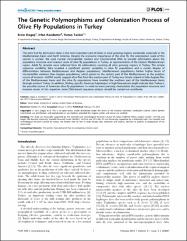The Genetic Polymorphisms and Colonization Process of Olive Fly Populations in Turkey
Özet
The olive fruit fly, Bactrocera oleae, is the most important pest of olives in olive growing regions worldwide, especially in the Mediterranean basin and North America. Despite the economic importance of the olive fly, the colonization route of this species is unclear. We used nuclear microsatellite markers and mitochondrial DNA to provide information about the population structure and invasion route of olive fly populations in Turkey, as representative of the Eastern Mediterranean region. Adult fly samples were collected from 38 sublocations covering all olive growing regions in Turkey. The simple sequence variability data revealed a significant genetic variability in olive fly populations and a certain degree of differentiation between Mediterranean and Aegean populations. Mediterranean populations harbor higher levels of microsatellite variation than Aegean populations, which points to the eastern part of the Mediterranean as the putative source of invasion. mtDNA results suggest olive flies from the western part of Turkey are closely related to Italo-Aegean flies of the Mediterranean basin and the olive fly populations have invaded the northern part of the Mediterranean basin through western Turkey. In addition, finding specific American haplotypes in high frequencies might indicate that Turkey is the possible source of American olive fly populations. In order to more precisely characterize the population structure and invasion routes of this organism, more DNA-based sequence analysis should be carried out worldwide.


















